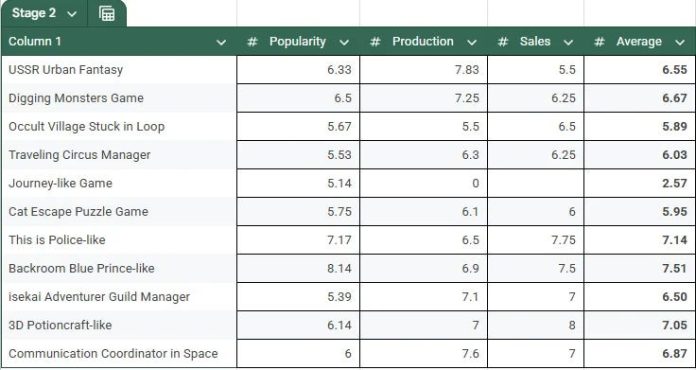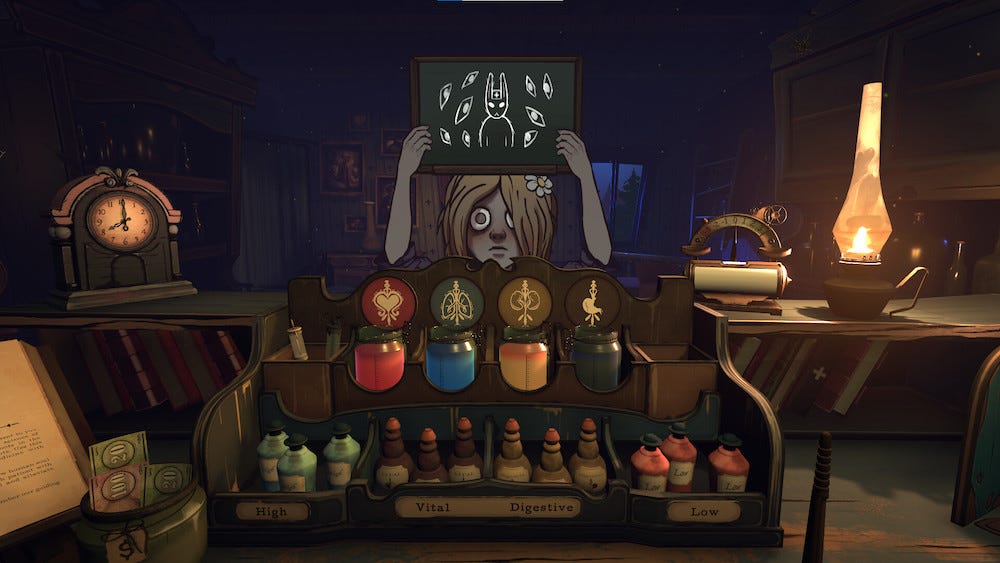[The GameDiscoverCo game discovery newsletter is written by ‘how people find your game’ expert & company founder Simon Carless, and is a regular look at how people discover and buy video games in the 2020s.]
Rounding off the week, as the summer holidays roll on (in the U.S.) and approach (in Europe, we think?), time to have a look around the world of PC and console game discovery once again. Again? Look, we enjoy it, don’t make us stop…
Before we start: “GameStop is auctioning off the stapler and staple that damaged a customer’s Nintendo Switch 2 for charity.” Wha? At launch, “an employee at the Staten Island branch… stapled the pre-order receipt to the front of a customer’s… box”, and it pierced the Switch 2 screen. The auction is at $242k – and we hope the winner pays.
OK, as the week peters out, let’s try to muster a little energy to examine the following game discovery goodness:
-
The latest ‘trad media’ mentions chart from Footprints.gg (above) is notable both because of what’s #1 – the PS5-exclusive (for now!) Death Stranding 2, which we think sold nearly 1m, but also for what’s #2 and #3 – ‘Xbox canceled these’ games Perfect Dark and Everwild. (They charted because they were canned, but oops.)
-
GDC 2026’s sole/only call for talk, panel & debate submissions is live, with an Aug. 7th deadline. And it looks like the old ‘Summits/Main Conf’ setup is no more, with organizers saying “refreshed with new formats, a unified structure, and a stronger focus on the full gaming ecosystem.” We look forward to hearing more…
-
More indications that Xbox Game Pass deals are concluded at a variety of initial up-front sums? A former biz dev person at Microsoft says on LinkedIn that he “negotiated 500+ [Game Pass] deals ranging from $50k to over $50m.” (Not sure there’s many at that second figure any more, which might have been a multi-game deal.)
-
Steamle is “a daily guessing game where you try to estimate how many user reviews popular Steam games have received. Everyone sees the same 5 games on any given date, making it a shared challenge for the gaming community!” (I got 370/500 on Thursday’s.)
-
It’s summer time, and the kids who play Roblox have more free time, but as David Taylor notes, the Grow A Garden market expansion effect is also being felt: “Just six months ago there were only 15 games on Roblox averaging over 50K concurrent players. Today there are 24 games with over 50K concurrent players.”
-
Microlinks, Pt.1: PlayStation Plus’ Game Catalog for July includes Cyberpunk 2077 (with a 30% DLC discount!), Abiotic Factor & Banishers; Epic Games settled its antitrust case against Samsung re: its Android app ‘auto blocker’; Nintendo’s Switch Game Vouchers (for cheaper premium games) are being discontinued.
-
May 2025’s Circana U.S. game hardware/select software charts are here – a tad later than normal. Total revenue was up 1% to $4.1b, with console game hardware down 13% to $172m. (But PS5 sales were up 3%, a rare YoY ‘beat’, and Switch 2 launch rush will arrive with the June data debuting in a couple of weeks.)
-
We skipped the first chunk of the ‘is Game Pass profitable?’ drama, but to cut to the chase, per Christopher Dring: “even when you include lost revenue associated with first-party games (not just unit sales, but microtransactions), Game Pass is still profitable.” (The costs for acquiring studios aren’t part of that equation, of course.)
-
Aream’s latest quarterly game biz insights – link, precis-ed version here via Game Dev Reports – has a lot of dense/good data: “The stock index for major diversified holdings (Tencent, Sony, Nintendo, Electronic Arts) grew 58% YoY in Q2’25. PC/console developers (Capcom, Square Enix, CDPR, Paradox Interactive) saw a 38% YoY increase.”
-
Over on Reddit, Polish gamers are mad at Steam for not adjusting ‘recommended pricing’: “In October 2022… Polish currency was at its lowest, with 1USD = 4.99PLN, and that’s exactly when Valve [made their last update]. The Polish currency came back to normal levels since then (currently 1USD = 3.62PLN)”. Hmm – Steam’s docs do claim a “commitment to refresh these price suggestions on a much more regular cadence”, too.
-
The Game Business used our wishlist data alongside IGN, Fandom & Fancensus charts to look at the ‘most anticipated games for the rest of 2025’, inc. Borderlands 4, Ghost Of Yotei, Hollow Knight: Silksong, and Mafia: The Old Country, the Metal Gear Solid 3 remake, Metroid Prime 4, The Outer Worlds 2 & more.
-
Microlinks, Pt. 2: Apple Arcade is launching 4 exclusives in August, including Play-Doh World and a Worms game; how cozy games are picking up interest on live streaming; the Indie Fan Fest Fall 2025 streaming showcase is specifically timed around the Oct. 2025 Steam Next Fest.
Back in April, we covered the (relative!) success of ‘Lovecraftian doctor sim’ Do Not Harm, a game from an Azerbaijan-based team (Darts) which grossed ~$500k in its first month. One of the things we noted at the time was that the team had “good understanding of hook and antecedents” – i.e. they understood successful Steam genres.
We’ve said this before, but truly understanding today’s market and identifying & playing games in the leading subgenres seems vital to success on PC & console. Why? Because the kind of game you make – its concept, hook, and product-market fit – is more important than anything else. (You need to execute too, of course…)
Anyhow, Darts’ Novruz Javadov just posted on Reddit about the process of picking their next game. And we think it’s a really interesting, metrics-led approach to game concept sifting. So let’s talk through it:
-
Step 1: understanding what type of games are ‘possible’ to make: Novruz links a notebook page and explains: “I prepared a set of risk levels for the team based on our skill level and budget. For us, Risk Level 0 was making a game similar to Do No Harm.” Risk level 2? Farming or horror games. Risk level 4? Co-op and Open World.
-
Step 2: present ideas – but based on specific criteria: internally, everyone could pitch, but based around two things: 1. “A hit game as a foundation that we’ll use for inspiration and as proof of commercial success.” 2. [describing the key initial] 10–15 seconds that will help players understand the genre and the hook.”
-
Step 3: evaluate the ideas on three specific dimensions: these were: “Popularity within the team (desire to make that game); Feasibility – scope and technical complexity (can we make that game?); Market potential (demand for such games and virality as we see it).”
The team at Darts – which has 19 full-time and 2-part time employees, by the way – ended up submitting eleven ideas, which are named here (and in the above header image) with the scoring. Great concepts here, including a Backrooms-y take on Blue Prince & a This Is The Police-like with new setting and Sultan’s Game elements.
Eight leads then met – production, creative, game design, art, marketing, narrative, QA, and development, fleshing out the three-dimension scoring. And three titles got to ‘5 votes out of 8’, leading to quite a lot of back and forth, detailed in the post.
In the end, the Darts team decided that “we’ll be working on a mix of 3D Potion Craft and Inscryption, set in the world of Do No Harm (possibly featuring our Witch.) That way, it also fits the best to the concept of Risk Levels we designed earlier.” So the highest rated game didn’t win – it was the #3 title. But there was a clear way to discuss & resolve that.
Look, we’re renowned process/data nerds at GameDiscoverCo. So of course we’re going to be excited about a data-led approach to deciding which game you should work on. But there’s three things that stand out with Darts’ approach:
-
Anchoring against another hit game stops ‘unclassifiable discovery’ misses: the #1 cause of failed discovery is ‘the average player can’t work out where this game fits into their world view’. This prevents that by using clear ‘anchor’ games up-front.
-
Blending internal popularity with feasibility & market potential is smart: the first is a ‘real’ number, while the other two are estimates. But they are all super-important to success. So having a robust real-world discussion on them is key.
-
A democratic-ish process should reinforce enthusiasm: I asked Novruz if he felt like everyone thought this a ‘fair’ process. And he said that it wasn’t perfect, but he hopes “our overall culture… makes it so that these conflicts are resolved quickly.”
We’re not saying all studios should do things this way. But for smaller, more agile devs, being a) grounded, b) market-aware and c) logical is an edge over the average ‘I have a single idea I’m in love with’ creator. They’re not looking at near-infinite game options. (They don’t have to! But more process, early sounds like a wonderful idea.)
While Valve’s taken its time in rolling out videos of talks originally premiered at GDC 2025, we can’t recommend them enough for practical advice. The latest one (above) is the Steam Early Access talk given by Alden Kroll, and the blurb explains:
“Learn how Early Access is meant to be a tool for developing your game while receiving player feedback. We’ll share how to best set expectations (for you and for your audience), and how to manage feedback.”
We featured 3 of the graphs from it back in March, but you can now watch it yourself – and you should do that. Some highlights we wanted to point out:
-
Valve agrees that how you approach Early Access has changed: Alden says up front: “It is still clearly relevant as a model for game developers and players, and it is also different now than it has been in the past”, concurring with all of us that “player expectations are higher as to the quality and polish of the game” for EA launch.
-
Being hyped to communicate with your players is key: talking to devs in Early Access, Alden noted that “making sure that their team was excited to engage with players, and organizing their team and their process” around that was vital. You need a clear plan of updates, community feedback, and the ability to be flexible.
-
Making ‘a splash’ with 1.0 was important to exiting Early Access: Alden noted that aligning other platform launches (like console) to 1.0 releases is great, but also stressed making “an update that was not just another update… but a bigger, maybe a capstone update”, so the 1.0 felt like something special.
It’s also good that Valve got several devs who were in Early Access to provide video soundbites for the YouTube talk, including Anton from Perfect Random (Sulfur), who we featured in the GDCo newsletter late last year.
So the overall keys to success, per the devs that Valve talked to? “Listening to feedback, communicating regularly, testing with [a] core group of fans [ahead of/during Early Access], and updating regularly.” There’s also some other good points on how to shape player feedback and planning for 1.0 price changes – all helpful stuff…




